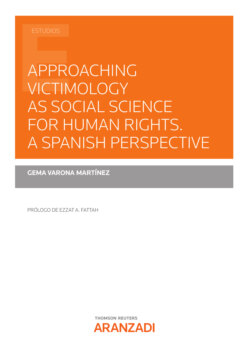Читать книгу Approaching Victimology as social science for Human rights a Spanish perspective - Gema Varona Martínez - Страница 29
На сайте Литреса книга снята с продажи.
1.1.1. Some remarks on the major milestones in Spain’s history of victim activism and policy defining the development of its victim rights and services3
ОглавлениеOn the major milestones in Spain’s history of victim activism and policy defining the development of its victim rights and services, five points can be highlighted:
1) The movement of victims of terrorism that fostered the first national legislation on compensation for victims in the 1980s (also influenced by the 1983 Council of Europe Convention; see the 4th additional provision of the 21/1986 Act, of December 23, on the Spanish budget for 1987).
2) The 35/1995 Act for the provision of aid and assistance to victims of violent crimes and sexual offences (following the 1983 Council of Europe Convention).
3) The feminist movement promotion of the adoption of the Organic Act 1/2004 of 28 December on integrated protection measures against gender violence.
4) The 2007 so-called Historical Memory Act (complemented by a 2021 draft on Democratic Memory) on victims of persecution during the Civil War and Francoism4.
5) The adoption of the Act 4/2015 of 27 April 2015 on the Statute of the Victim of Crime (transposing the 2012/29/EU Directive on victims’ rights).
Among the main victim stories or events and their impact on the Spanish victim policy or practice, we can recall the following:
1) The emergence of the Association for Victims of Terrorism, created by several women victims of the terrorist group ETA, among them, Ana María Vidal-Abarca López (Alonso, 2017), in 1981, when there was no support for them, despite the number of killings and attacks.
2) The Alcasser case5, regarding three female teenagers kidnapped, raped and murdered which initiated the public debate on the secondary victimisation caused by the media.
3) The murder of Ana Orantes6, which raised awareness and influenced the approval of the Organic Act 1/2004 of 28 December on integrated protection measures against gender violence.
4) The La Manada case7 in which gang or group rape victimisation contributed to forcing the revision of the criminal legislation on consent and sexual crimes with an integral law on sexual violence. Before that case, the case of conservative Spanish councillor Nevenka Fernández who spoke out against sexual harassment in 2001 was overlooked, but it was brought back to prominence in 2021 because of the release of a Netflix documentary film about the case8.
5) The case of Maixabel Lasa9 who, with other victims, helped to open the debate on the use of restorative justice for terrorism (Martín y Rodríguez, 2019), but also for other serious crimes in the context of prison.
6) The Romanones case in Granada in which sexual abuse in the Church against minors was reported in 2014. The accused was finally declared innocent. The Supreme Court indicated that there was some evidence to investigate the case, although insufficient for a sentence, in a case where several alleged crimes could not be brought to justice because of the statute of limitations. After this case, along with the activism in other countries, the victims’ movement on this sort of victimisation started to grow in Spain to ask for reparation by the Church, as well a reform of the statute of limitations and better protection for child victims10.
In general, Spain does not have high rates of registered victimisation. Despite the lack of sustainable victim surveys, according to police statistics (briefly mentioned in a previous chapter), registered crime is steady or decreasing. In the last years, sexual violence and gender violence is growing slightly, particularly in the cyber space. There is an emerging social awareness on the victimisation of victims of hate crimes; human trafficking; police brutality and sexual abuse in institutional settings (schools, sports clubs, etc.). There is also a growing academic interest in quantifying victims of corporate, environmental and white-collar crime in general, although this is mostly considered as diffuse victimisation.
Beyond criminal victimisation, the term “victim” is also deployed in Spain today for victims such as the victims of the Covid-19; victims of natural disasters; victims of suicides (Tollefson, 2015)11; and victims of accidents.
